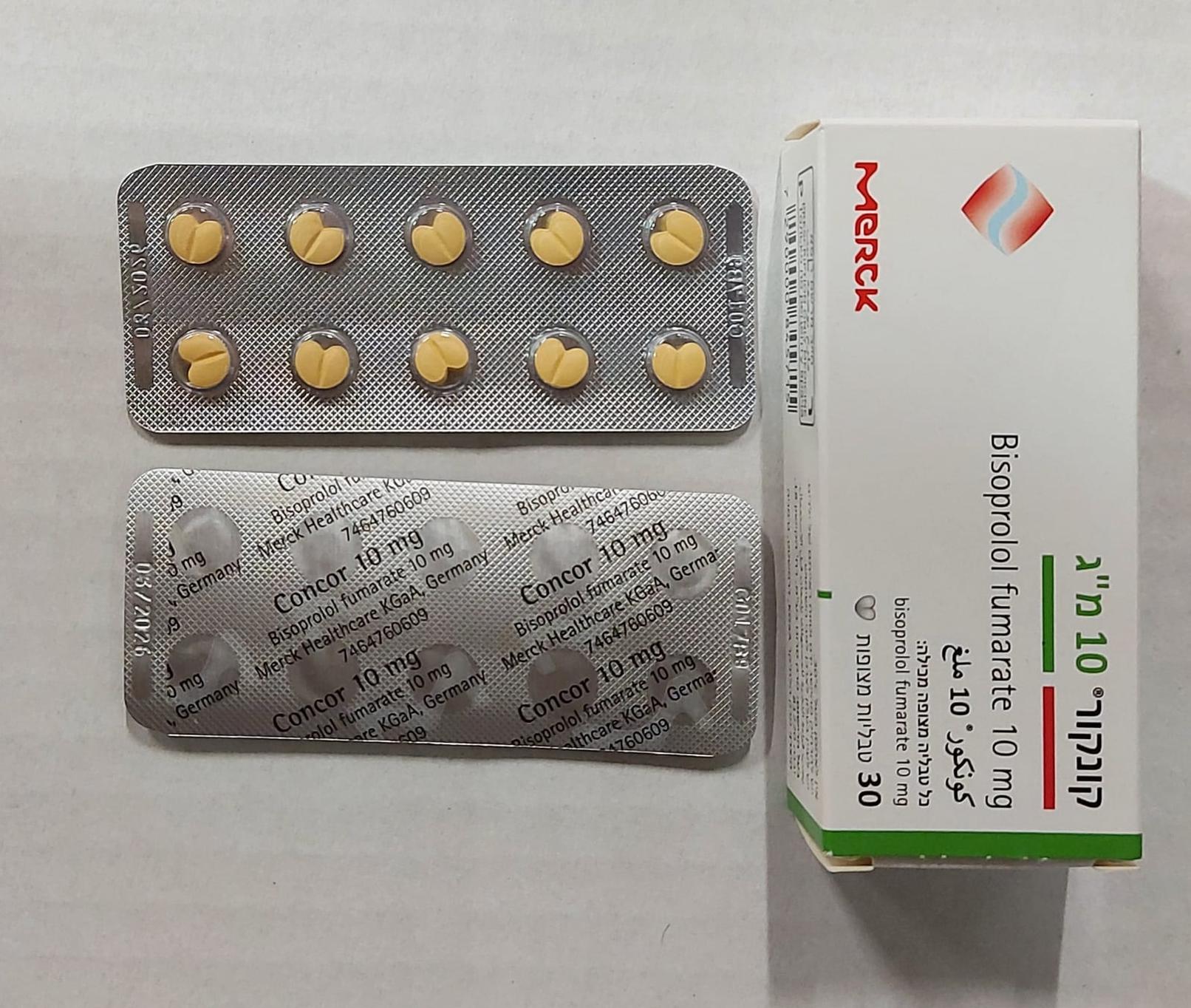Quest for the right Drug

קונקור 10 מ"ג CONCOR 10 MG (BISOPROLOL FUMARATE)
תרופה במרשם
תרופה בסל
נרקוטיקה
ציטוטוקסיקה
צורת מתן:
פומי : PER OS
צורת מינון:
טבליה : TABLETS
עלון לרופא
מינוניםPosology התוויות
Indications תופעות לוואי
Adverse reactions התוויות נגד
Contraindications אינטראקציות
Interactions מינון יתר
Overdose הריון/הנקה
Pregnancy & Lactation אוכלוסיות מיוחדות
Special populations תכונות פרמקולוגיות
Pharmacological properties מידע רוקחי
Pharmaceutical particulars אזהרת שימוש
Special Warning עלון לרופא
Physicians Leaflet
Pharmacological properties : תכונות פרמקולוגיות
Pharmacodynamic Properties
5.1 Pharmacodynamic properties Pharmacotherapeutic group: Beta blocking agents, selective ATC Code: C07AB07 Mechanism of action Bisoprolol is a highly beta1-selective-adrenoceptor blocking agent, lacking intrinsic stimulating and relevant membrane-stabilising activity. It only shows low affinity to the beta2-receptor of the smooth muscles of bronchi and vessels as well as to the beta2- receptors concerned with metabolic regulation. Therefore, bisoprolol is generally not to be expected to influence the airway resistance and beta2-mediated metabolic effects. Its beta1-selectivity extends beyond the therapeutic dose range. Clinical efficacy and safety In total 2647 patients were included in the CIBIS II trial. 83% (n = 2202) were in NYHA class III and 17% (n = 445) were in NYHA class IV. They had stable symptomatic systolic heart failure (ejection fraction <35%, based on echocardiography). Total mortality was reduced from 17.3% to 11.8% (relative reduction 34%). A decrease in sudden death (3.6% vs 6.3%, relative reduction 44%) and a reduced number of heart failure episodes requiring hospital admission (12% vs 17.6%, relative reduction 36%) was observed. Finally, a significant improvement of the functional status according to NYHA classification has been shown. During the initiation and titration of bisoprolol hospital admission due to bradycardia (0.53%), hypotension (0.23%), and acute decompensation (4.97%) were observed, but they were not more frequent than in the placebo-group (0%, 0.3% and 6.74%). The numbers of fatal and disabling strokes during the total study period were 20 in the bisoprolol group and 15 in the placebo group. The CIBIS III trial investigated 1010 patients aged ≥65 years with mild to moderate chronic heart failure (CHF; NYHA class II or III) and left ventricular ejection fraction ≤35%, who had not been treated previously with ACE inhibitors, beta-blockers, or angiotensin receptor blockers. Patients were treated with a combination of bisoprolol and enalapril for 6 to 24 months after an initial 6 months treatment with either bisoprolol or enalapril. There was a trend toward higher frequency of chronic heart failure worsening when bisoprolol was used as the initial 6 months treatment. Non inferiority of bisoprolol-first versus enalapril-first treatment was not proven in the per-protocol analysis, although the two strategies for initiation of CHF treatment showed a similar rate of the primary combined endpoint death and hospitalization at study end (32.4% in the bisoprolol-first group vs. 33.1 % in the enalapril-first group, per-protocol population). The study shows that bisoprolol can also be used in elderly chronic heart failure patients with mild to moderate disease. Bisoprolol is also used for the treatment of hypertension and angina. In acute administration in patients with coronary heart disease without chronic heart failure bisoprolol reduces the heart rate and stroke volume and thus the cardiac output and oxygen consumption. In chronic administration the initially elevated peripheral resistance decreases.
Pharmacokinetic Properties
5.2 Pharmacokinetic properties Absorption Bisoprolol is absorbed and has a biological availability of about 90% after oral administration. Distribution The distribution volume is 3.5 l/kg. The plasma protein binding of bisoprolol is about 30%. Biotransformation and Elimination Bisoprolol is excreted from the body by two routes. 50% is metabolised by the liver to inactive metabolites which are then excreted by the kidneys. The remaining 50% is excreted by the kidneys in an unmetabolised form. Total clearance is approximately 15 l/h. The half-life in plasma of 10-12 hours gives a 24 hour effect after dosing once daily. Linearity The kinetics of bisoprolol are linear and independent of age. Special population Since the elimination takes place in the kidneys and the liver to the same extent a dosage adjustment is not required for patients with impaired liver function or renal insufficiency. The pharmacokinetics in patients with stable chronic heart failure and with impaired liver or renal function has not been studied. In patients with chronic heart failure (NYHA stage III) the plasma levels of bisoprolol are higher and the half-life is prolonged compared to healthy volunteers. Maximum plasma concentration at steady state is 64+21 ng/ml at a daily dose of 10 mg and the half-life is 17+5 hours.

שימוש לפי פנקס קופ''ח כללית 1994
לא צוין
תאריך הכללה מקורי בסל
לא צוין
הגבלות
לא צוין
מידע נוסף
